How to Open Durian Fruit? 8 Easy Steps!
To open a durian, you will need gloves or a towel to protect your hands, a sharp knife, and a flat surface. First, put on the gloves or wrap the towel around your hands.
Then, locate the seams running down the durian’s shell. Gently push the knife into one of these seams and twist it to pry the shell apart.
Once you have a large enough opening, pull the sections apart with your hands. Inside, you’ll find the edible flesh in segments, which can be removed and enjoyed.
Opening a durian fruit, known for its strong odor and thorny husk, requires care and technique.
The steps listed provide a safe method to access the creamy fruit inside:
Familiarizing oneself with these steps simplifies the process and ensures a safe and enjoyable durian experience.
Unlocking the pungent treasures of a durian requires skill, but with the right tools and technique, you can savor its unique flavor without much fuss.

Key Takeaway
Understanding Durian Characteristics

Before attempting to open a durian, it is essential to recognize its unique physical traits, which include a hard, spiky outer shell and a distinctive odor.
This tropical fruit, revered in many Southeast Asian cultures, is as notorious for its pungent scent as it is celebrated for its rich, custard-like interior. The formidable husk conceals pods of creamy flesh, each segment a culinary delight to enthusiasts.
To handle a durian effectively, you must respect its armor-like exterior, which serves as a natural deterrent.
The spikes are sharp, requiring careful manipulation to avoid injury. An understanding of the durian’s anatomy facilitates a safer and more efficient opening process.
Enthusiasts appreciate the durian’s complexity, embracing the challenge with both anticipation and respect for this king of fruits.
Step 1: Selecting the Perfect Durian

To successfully open a durian, one must first select a ripe specimen, indicated by a slightly yielding shell and a strong, distinctive aroma. The quest for the perfect durian is an art form, blending intuition with sensory cues.
Look for fruit that feels heavy for its size, a sign of ample creamy flesh within. Gently press the shell; readiness is suggested by a subtle give, but beware of overly soft spots which may signal overripeness or decay.
Listen to the call of its scent; a mature durian will emit a potent fragrance that is detectable even through its thorny armor. A balance of firmness and aroma heralds a prime candidate.
Now that the ideal durian is in hand, the next step awaits: preparing your tools.
Step 2: Preparing Your Tools
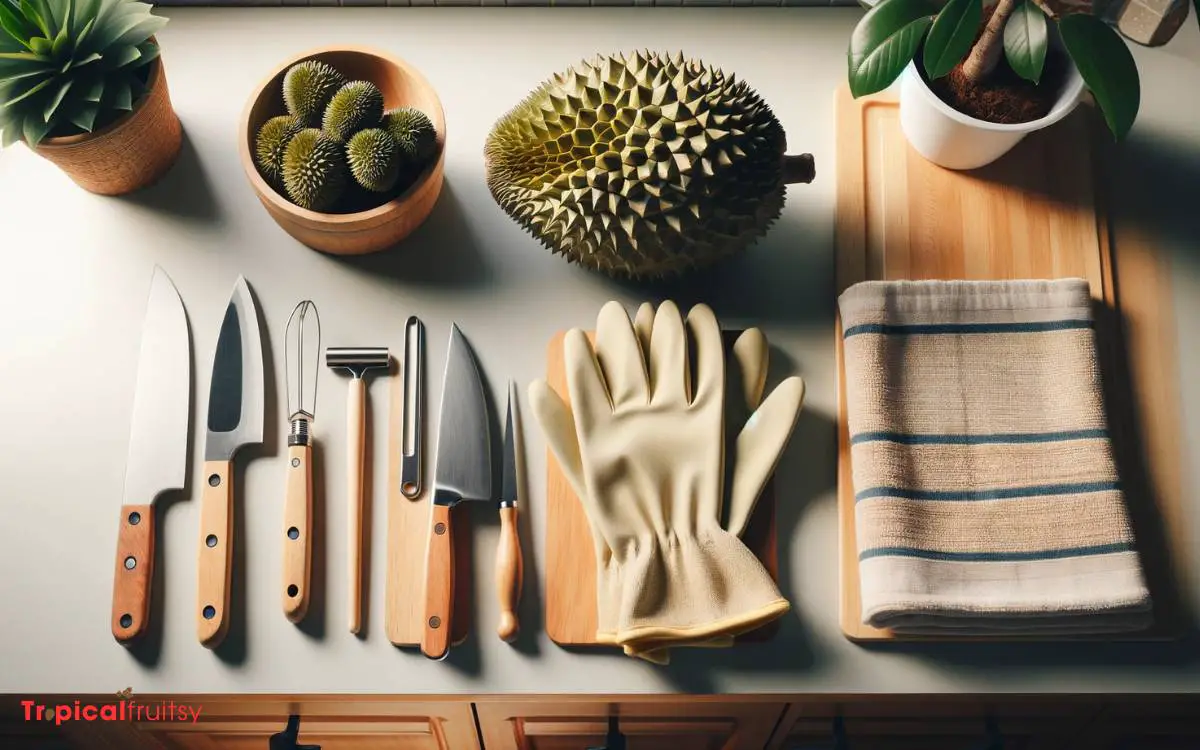
Gathering the appropriate implements is a crucial step in the process of opening a durian fruit.
To tackle this formidable task with finesse, ensure you have the following tools at your disposal:
- A sharp, sturdy knife: Essential for piercing the durian’s tough exterior.
- Heavy-duty gloves: To protect your hands from the spiky husk.
- A large cutting board: Offers a stable surface to work on and contains any mess.
Armed with these items, you’ll be poised to expertly breach the durian’s armor-like rind. The right tools not only make the process safer but also significantly more efficient.
Step 3: Protective Measures
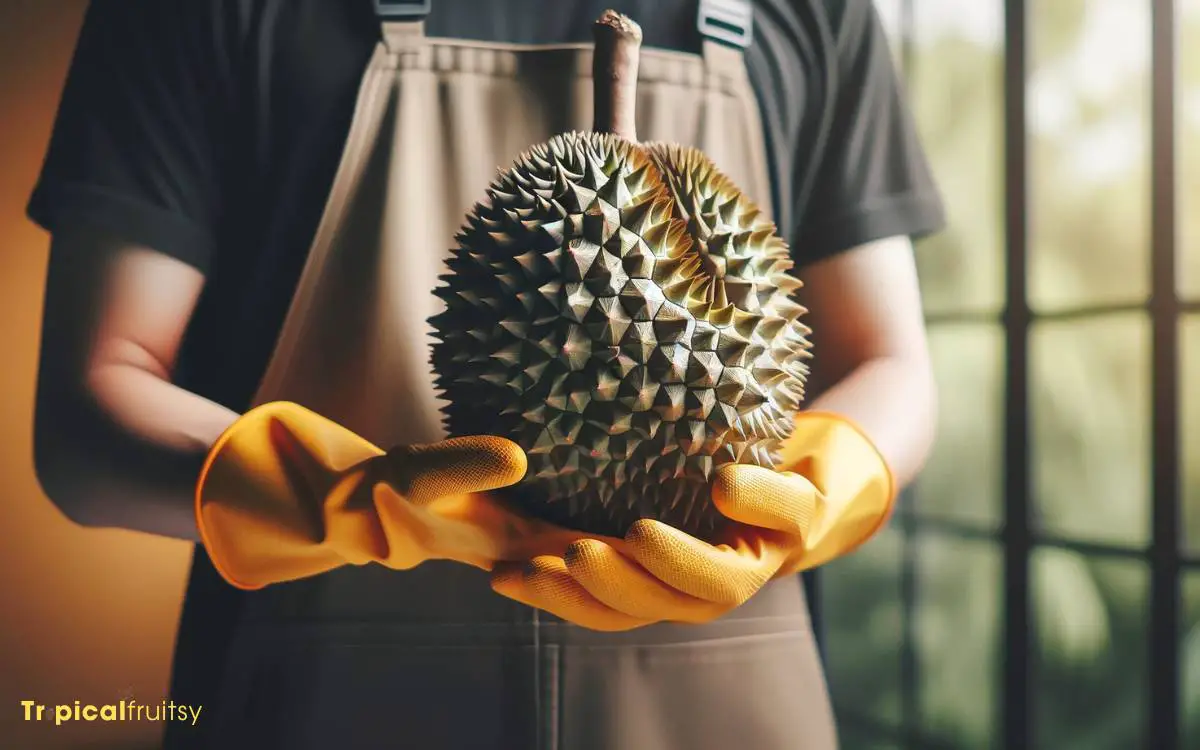
Why should you don protective gear when opening a durian, and what safety precautions are necessary?
The durian’s outer husk is notoriously spiky and can cause injury if mishandled. To ensure a safe experience, enthusiasts should wear thick gloves to protect their hands from the sharp spikes.
Additionally, eye protection is advisable to guard against any unexpected slips that might propel parts of the spiky husk towards your face. It’s also wise to work on a stable, flat surface to prevent the durian from rolling and causing potential harm.
A methodical approach not only ensures your safety but also enhances the enjoyment of revealing the succulent treasure inside.
Now that you’re equipped with knowledge on safety measures, let’s proceed to the crucial step of identifying the seams, the natural lines that guide the best opening strategy.
Step 4: Identifying the Seams
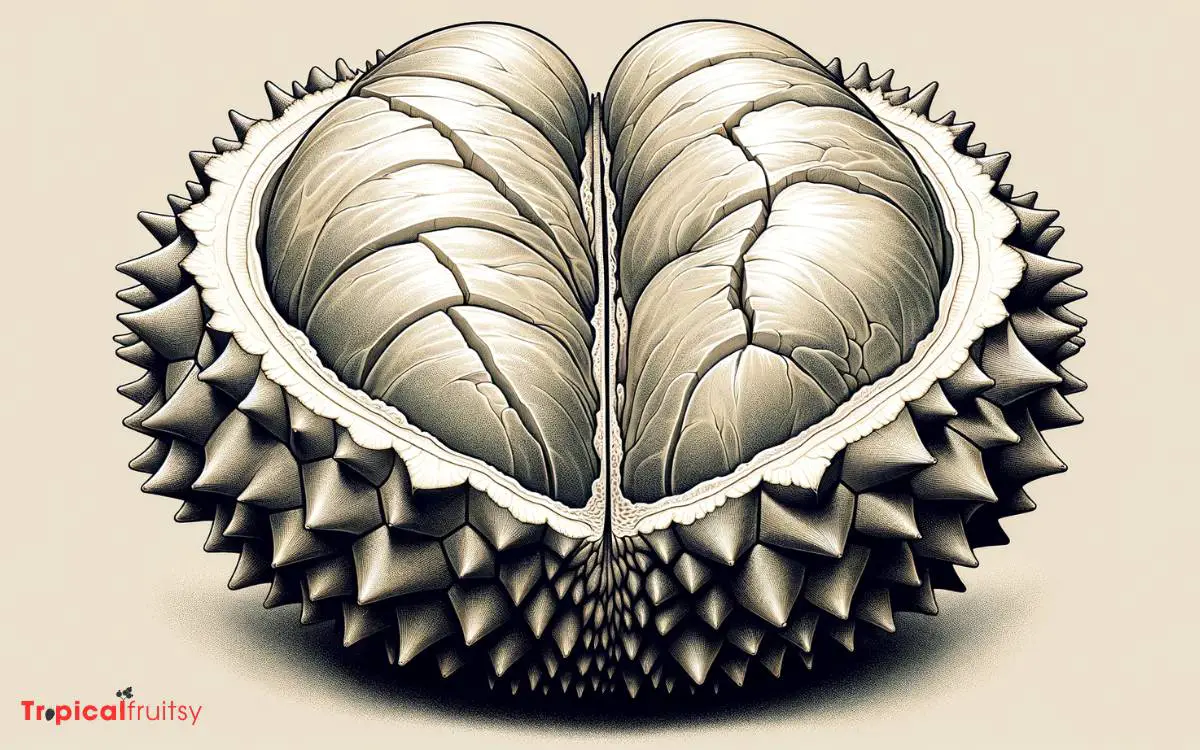
To adeptly open a durian, one must first recognize the natural lines that demarcate the segments of its formidable shell.
These seams are the weak points where the fruit is most easily pried apart, and learning to identify them is a crucial step in the process.
Observing the texture and pattern of the durian’s exterior will enable you to locate these lines and proceed with confidence.
Spotting Natural Lines
Although durians have a formidable appearance, one can open them with relative ease by locating the natural lines or seams that run along the fruit’s husk.
These lines are the pathways to the luscious interior, and identifying them is a pivotal step in the durian-opening process.
Here’s what to look for:
- Visual Clues: Search for slightly raised ridges or depressions that indicate the underlying structure of the lobes.
- Symmetrical Pattern: Note the star-like pattern often present at the bottom of the fruit, which can guide you to the seams.
- Color Variation: Look for subtle changes in color or texture along the husk that may signal the natural divisions.
Durian Shell Texture
The durian’s husk exhibits a distinctive texture that, upon closer inspection, reveals the seams crucial for a successful opening.
These seams, often more subtle than the spiky exterior suggests, are the key to unlocking the delectable flesh within. Enthusiasts know that the art of identifying these seams comes with experience and a careful touch.
For novices, the task might seem daunting, but with the right approach, it becomes a rewarding endeavor.
To aid in the identification process, consider the following table highlighting characteristics of the durian shell:
| Feature | Description | Relevance |
|---|---|---|
| Spikes | Sharp protuberances | Can obscure seams |
| Color | Varies from green to brown | May hint at seam locations |
| Texture | Tough, fibrous | Protects the fruit inside |
| Pattern | Star-like ridges | Indicates starting points for opening |
| Feel | Uneven, rigid | Guides hand placement and pressure |
Understanding these elements enhances your ability to approach this tropical delicacy with confidence and gusto.
Step 5: Cutting the Husk
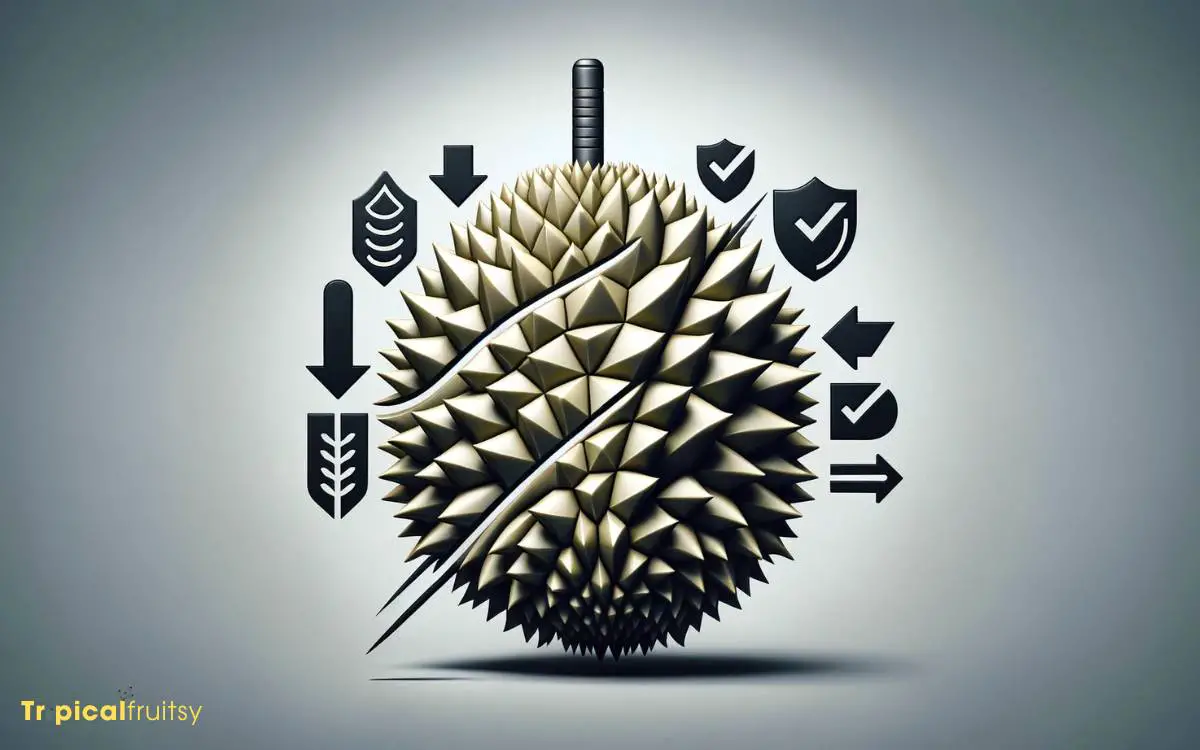
Once you have identified the natural seams of the durian, use a sharp knife to carefully cut through the thick husk.
Approach this task with precision and patience; the outer layer of the durian is notoriously tough, but your efforts will soon be rewarded with the unique experience of tasting its custard-like flesh.
To facilitate this process:
- Wear gloves: The spiky shell can be painful to handle.
- Insert the knife shallowly: Avoid damaging the fruit inside.
- Leverage the seams: Follow the natural lines for easier cutting.
Embrace the challenge with enthusiasm; opening a durian is a culinary adventure like no other!
Step 6: Prying the Fruit Open
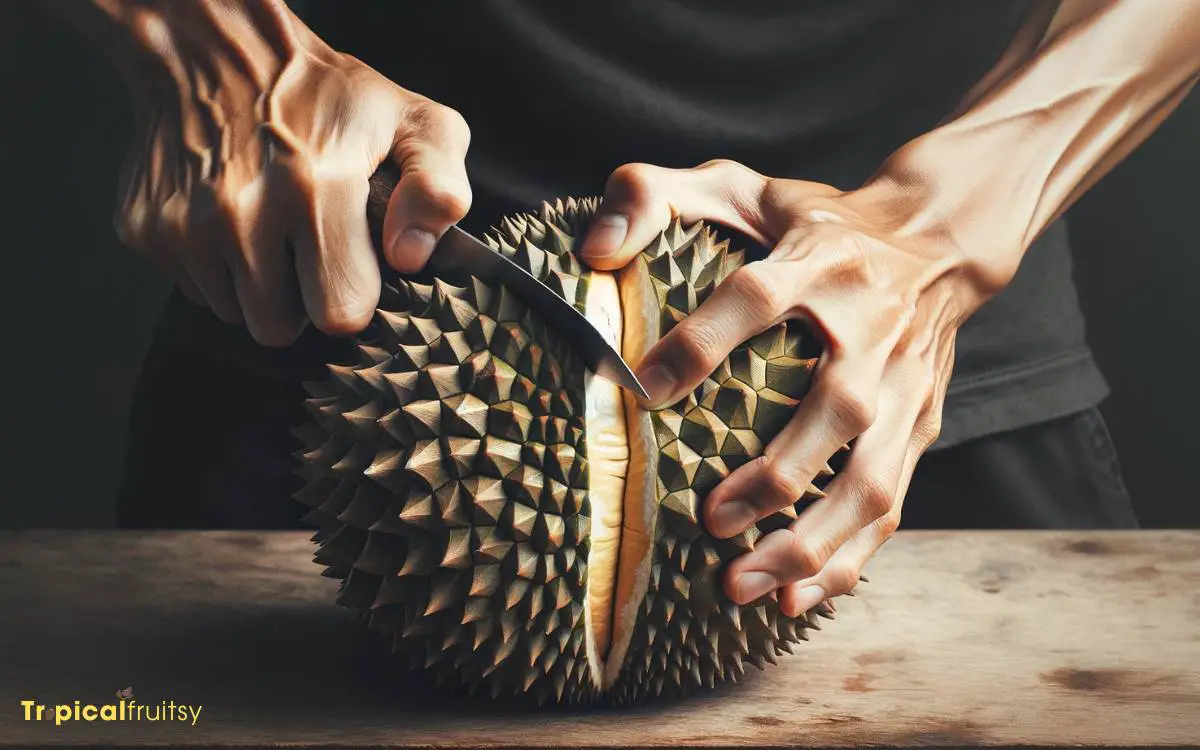
Once the husk of the durian has been scored, the next step is to effectively pry the fruit open.
Identifying the natural seams in the durian is critical for leveraging the fruit apart without excessive force.
Carefully utilize sharp tools to gently work these seams, easing the sections apart to reveal the succulent flesh within.
Find Natural Seams
Identifying the durian’s natural seams is a crucial first step in prying the fruit open effectively.
These seams are the lines along which the durian is most likely to split open with the least resistance, revealing its succulent flesh inside.
Unearthing these seams can be a tactile exploration, and once located, they serve as your roadmap to durian delight.
To captivate your interest, consider the following:
- Locate the Star: Look for the star-like pattern on the bottom of the fruit.
- Gentle Pressure: Apply gentle pressure along the seams to feel for give.
- Visual Cues: Observe the durian’s shape; the seams often run between the spikes.
This methodical approach ensures a cleaner and safer opening process.
Use Sharp Tools
Armed with the knowledge of the durian’s natural seams, one must now employ a sharp knife or other appropriate tool to carefully pry the fruit open. The objective is to make a shallow incision along these seams to create a leverage point.
From here, one can insert a knife or a durian opener and begin to gently twist and pry the fruit apart. It’s crucial to proceed with caution, as the spiky exterior can be hazardous.
| Step | Tool | Action |
|---|---|---|
| 1. Incise | Sharp Knife | Make a shallow cut along the seam. |
| 2. Insert | Durian Opener | Place the opener in the incision. |
| 3. Pry Open | Hands/Gloves | Apply pressure to open the durian with protection. |
Utilizing the proper tools and technique ensures a successful and safe durian opening experience, revealing the luscious fruit inside for your enjoyment.
Step 7: Removing the Flesh
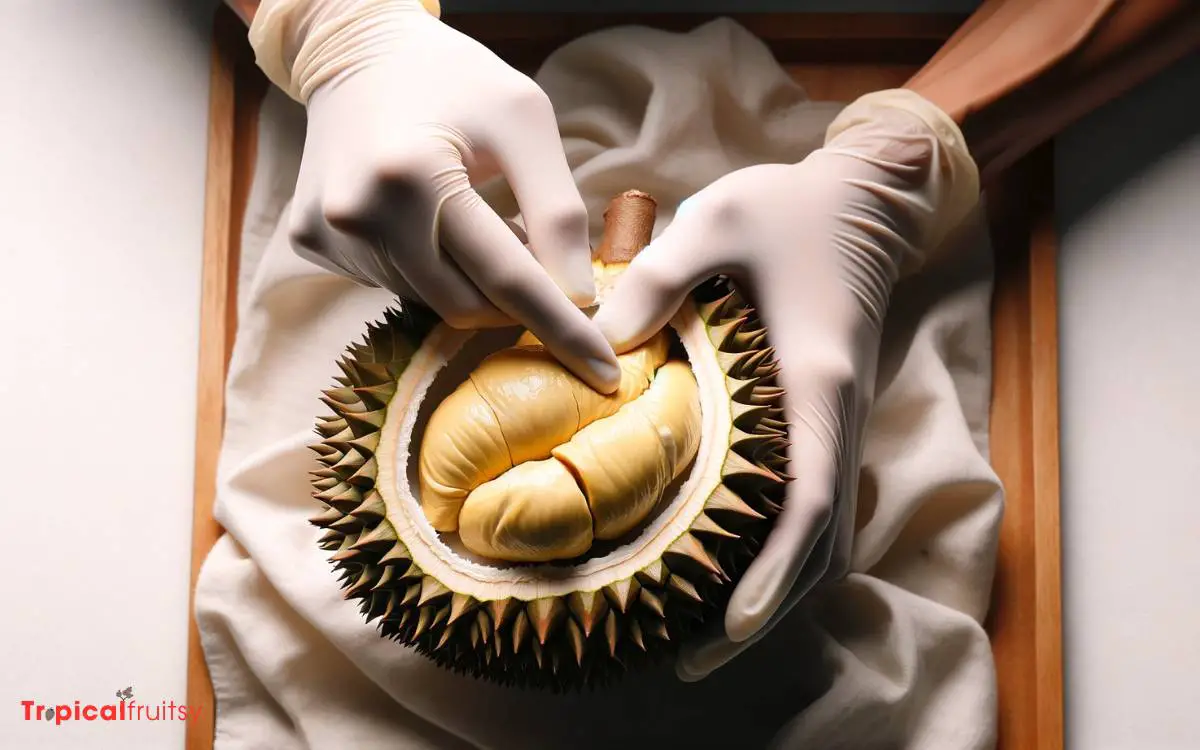
Upon splitting the durian shell, carefully extract the creamy flesh from within the compartments using a paring knife or your hands.
The golden, custard-like pulp is nestled in pockets lined with fibrous husk, and detaching it without compromising its integrity requires a blend of gentleness and precision.
Here are a few tips to master the art of durian flesh removal:
- Use the Right Technique: Slide the knife along the seams or pry the lobes apart with your fingers.
- Preserve the Texture: Gently lift the flesh to maintain its plush consistency.
- Avoid the Seeds: Each section contains a large seed; work around it to separate the edible portion.
This process, while straightforward, captivates with its promise of a rich and exotic taste experience for those who appreciate the unique flavor of durian.
Step 8: Storing Leftover Durian

Once the durian flesh is removed, proper storage is crucial to preserve its flavor and freshness for future consumption.
If you find yourself with more delectable durian than you can eat at once, worry not! Your leftover bounty can be kept in the refrigerator; simply place the pulp in an airtight container to prevent it from absorbing other odors.
For longer preservation, freezing is an excellent option. Seal the flesh in freezer bags, expelling as much air as possible before sealing to prevent freezer burn. This method can retain the durian’s taste and texture for up to two months.
Remember, defrosting should be done gradually in the refrigerator to maintain the fruit’s rich consistency.
Enjoy your durian delight at a later date without sacrificing its exotic charm!
How to Open Durian Without Knife
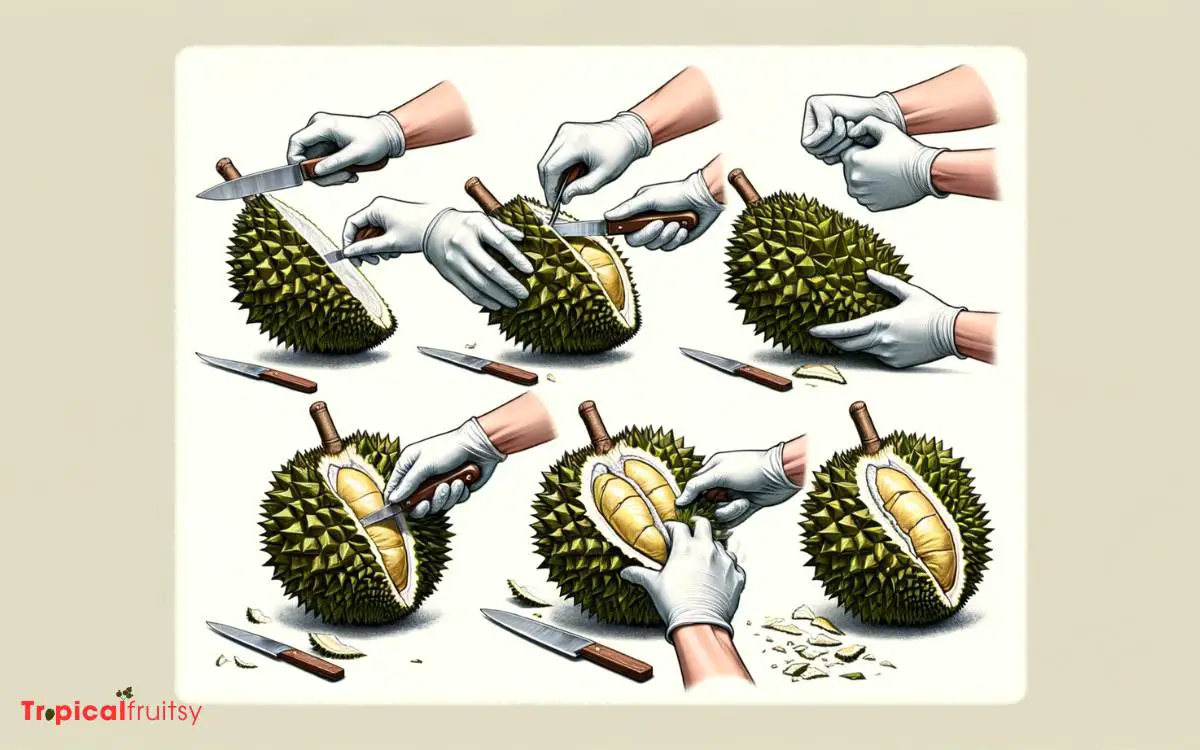
Opening a durian without a knife can be a bit tricky, but it’s possible with a few alternative methods.
Here’s how you can do it without using a knife:
Using Gloves and a Cloth: Put on a pair of thick gloves to protect your hands from the sharp spikes of the durian. Then, wrap the durian in a thick cloth or towel.
Hold the durian firmly with both hands and press it against a hard surface, such as the floor or a sturdy table.
Apply enough pressure to crack the outer shell. Once cracked, you can use your hands to pull the shell apart further and access the flesh inside.
Using a Hammer or Mallet: If you have a hammer or mallet available, you can use it to crack open the durian. Place the durian on a stable surface, such as a cutting board or the ground.
Hold the hammer or mallet with both hands and carefully strike the durian’s shell along the seams.
Be cautious not to hit too hard, as you don’t want to damage the fruit inside. Once cracked, you can use your hands to pry the shell open further.
Using a Rock or Heavy Object: If you’re outdoors or in an area where you can find a suitable heavy object, such as a large rock, you can use it to crack open the durian.
Place the durian on the ground and position the heavy object above it. Drop or gently lower the object onto the durian’s shell to crack it open. Again, be careful not to apply too much force to avoid damaging the fruit inside.
Using Gravity: In some cases, you can simply drop the durian from a height onto a hard surface to crack it open. This method works best if the durian is already ripe and the shell is slightly softened.
Hold the durian at arm’s length and drop it onto a hard surface, such as concrete or pavement. Repeat the process until the shell cracks open, then use your hands to separate it further and access the flesh inside.
Whichever method you choose, remember to handle the durian with care and be mindful of the sharp spikes on the outer shell. Once opened, you can enjoy the delicious and creamy flesh of the durian.
Conclusion
In the odyssey of sensory exploration, the durian stands as a formidable citadel, its armor yielding only to the diligent.
As the seams part to reveal the fleshy treasure within, one is reminded of the triumph of persistence and the sweet rewards of curiosity.
This delicacy, once veiled in thorns, now offers its ambrosial secrets to those who dare to unlock its mysteries, a testament to the enduring allure of nature’s hidden bounties.






